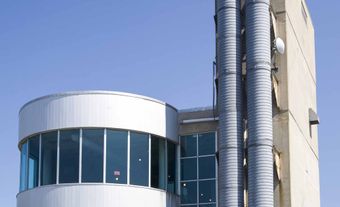Geothermal Energy is the exploitable heat within the Earth. The interior of the planet is maintained at a high temperature by a vast store of heat, of which part remains from the formation of the Earth and part is continually generated by the decay of radioactive elements. Heat generated is roughly balanced by heat escaping through conduction to the surface, geysers and hot springs, and volcanic action. Some of this energy becomes concentrated in deposits that can be tapped; research into geothermal energy seeks to discover new deposits of heat and to improve exploration and exploitation technology. Geothermal energy involves a relatively new technology compared to that developed for fuels such as oil or gas, but as these finite resources are used and become more expensive geothermal energy will grow in importance.
Most geothermal deposits involve a coincidence of water and heat. Surface water sinks into the ground, some of it penetrating deep into cracks or porous rocks where it may become trapped in large reservoirs for long periods. In stable, nonvolcanic parts of the Earth's crust, temperature increases in a downward direction at an average rate of about 25°C/km, and hot reservoirs are found only where porous rocks extend to depths that are hot under normal conditions. These are usually in large sedimentary basins, in the rocks that sometimes hold petroleum deposits. In volcanic areas, water becomes intensely heated at shallow depth and some reservoirs become large deposits of exploitable energy. A few reservoirs, eg, Larderello in Italy, contain steam at about 235°C, but most contain water under high pressure at temperatures up to 400°C. When temperatures are higher than 200°C, reservoirs can be drilled for steam to drive turbines for production of electricity. Geothermal waters at lower temperatures can be used for many direct applications (eg, heating buildings, drying crops). Some hot rocks do not have a convenient water stream to extract their heat and an artificial circulation system must be created. Such a system is being developed in the US at Los Alamos, where a pair of holes have been drilled, the rock between has been fractured to complete the circulation path, and electric power has been generated.
In Canada geothermal potential is found in the sedimentary rocks of the prairies and in a broad band bordering the oceans. The central area of the Canadian landmass, the shield, is too old and cool to yield useful heat. The total potentially usable heat in hot water in the sediments of the prairies is equivalent to 300 times Canada's total energy needs in 1987, but only a small fraction of this heat is readily exploitable at current energy prices and with current technology. British Columbia's mountains contain about a dozen volcanic centres that may have geothermal deposits capable of producing electric power. There are also hot dry-rock deposits in volcanic centres and more widespread zones of intrusive rocks, and in small sedimentary basins that may be abnormally warm. One of the volcanic centres, Mt Meager, was drilled by BC Hydro in 1981 for geothermal steam. Temperatures of about 250°C were encountered, but the project to build a 50 Mw plant has been abandoned, pending future energy shortages. By the mid-1990s, industrial companies were working to revive the project and to generate power for export. In the arctic islands, the Sverdrup Basin probably holds a large geothermal resource, but opportunities for using it are few. There is a deep sedimentary basin under PEI and the Gulf of St Lawrence, but little is known about its temperature and water content. The Atlantic margin of Canada also contains large granitic bodies, some with sufficient heat production from radioactivity to give high temperature at a depth of about 3 km. The town of Springhill, NS has developed the geothermal use of water from the flooded coal mines that underlie the town. Water is pumped from shallow parts of the old mines and emerges at about 18°C. This water is run through heat pumps that provide heat in winter and cooling in summer to industrial buildings, and the used water is returned to the mines. By 1994 there were eight users in the town's industrial park, and they report large savings in the cost of energy, as well as improved working conditions.
The US, Japan, Italy, New Zealand, Iceland, France, Hungary and several other countries are already using geothermal energy for electric-power generation, residential and commercial heating, and agricultural and industrial processes. In volcanic areas, geothermal energy seems to be renewable, provided that extraction rates are carefully controlled. In sedimentary basins it is not renewable at a reasonable rate and parts of the reservoir can be cooled to a level from which it will recover only after a few hundred years. Harmful environmental effects are few - usually the result of failing to reinject cooled water.

 Share on Facebook
Share on Facebook Share on X
Share on X Share by Email
Share by Email Share on Google Classroom
Share on Google Classroom


